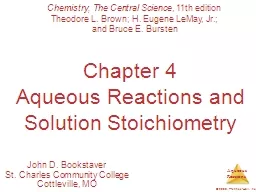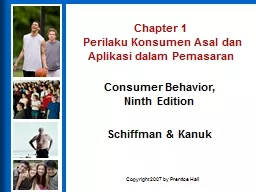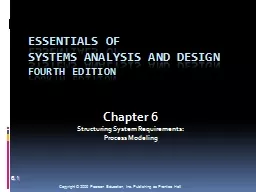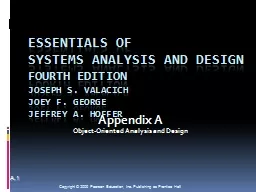PPT-© 2009, Prentice-Hall, Inc.
Author : cheryl-pisano | Published Date : 2015-12-03
Chapter 4 Aqueous Reactions and Solution Stoichiometry John D Bookstaver St Charles Community College Cottleville MO Chemistry The Central Science 11th edition
Presentation Embed Code
Download Presentation
Download Presentation The PPT/PDF document "© 2009, Prentice-Hall, Inc." is the property of its rightful owner. Permission is granted to download and print the materials on this website for personal, non-commercial use only, and to display it on your personal computer provided you do not modify the materials and that you retain all copyright notices contained in the materials. By downloading content from our website, you accept the terms of this agreement.
© 2009, Prentice-Hall, Inc.: Transcript
Chapter 4 Aqueous Reactions and Solution Stoichiometry John D Bookstaver St Charles Community College Cottleville MO Chemistry The Central Science 11th edition Theodore L Brown H Eugene LeMay Jr and Bruce E Bursten. Chapter 8. Concepts of Chemical Bonding. Chemistry, The Central Science. , 11th edition. Theodore L. Brown, H. Eugene LeMay, Jr., and Bruce E. Bursten. John D. Bookstaver. St. Charles Community College. Chapter 7. Periodic Properties. of the Elements. Chemistry, The Central Science. , 11th edition. Theodore L. Brown; H. Eugene LeMay, Jr.; . and Bruce E. Bursten. John D. Bookstaver. St. Charles Community College. Chapter 1. Introduction:. Matter and Measurement. John D. Bookstaver. St. Charles Community College. Cottleville, MO. Chemistry, The Central Science. , 11th edition. Theodore L. Brown; H. Eugene LeMay, Jr.; and Bruce E. Bursten. Chapter 8. Concepts of Chemical Bonding. Chemistry, The Central Science. , 11th edition. Theodore L. Brown, H. Eugene LeMay, Jr., and Bruce E. Bursten. John D. Bookstaver. St. Charles Community College. Chapter 1. . Perilaku Konsumen Asal dan . Aplikasi dalam Pemasaran . Copyright 2007 by Prentice Hall. Types of Consumers. Personal Consumer . membeli barang dan jasa untuk personal, rumahtangga, atau anggota keluarga bahkan teman. . CONSUMER BEHAVIOR, . 10e. Michael R. Solomon. 5-. 2. Copyright © . 2013 . Pearson Education, Inc. publishing as Prentice Hall. Chapter Objectives. When you finish this chapter, you should understand why:. Chapter 9 - . 1. Writing Persuasive Messages. © Prentice Hall, 2007. Business Communication Essentials, 3e. Chapter 7 - . 2. Key Writing Concepts. Organization. Active/passive language. “You” orientation . Chapter 7 - . 1. Writing Routine and Positive Messages. © Prentice Hall, 2007. Business Communication Essentials, 3e. Chapter 7 - . 2. Key Writing Concepts. Organization. Active/passive language. “You” orientation . Forecasting Components. Time Series Methods. Forecast Accuracy. Time Series Forecasting Using Excel. Time Series Forecasting Using QM for Windows. Regression Methods. Chapter Topics. Copyright © 2013 Pearson Education, Inc. Publishing as Prentice Hall. Essentials of. Systems Analysis and Design. Fourth Edition. Chapter 6 . Structuring System Requirements:. Process Modeling. 6.1. Learning Objectives. Explain process modeling. Discuss data-flow diagramming mechanics, definitions, and rules . Chapter 11. Intermolecular Forces, Liquids, and Solids. John D. Bookstaver. St. Charles Community College. Cottleville, MO. Chemistry, The Central Science. , 11th edition. Theodore L. Brown, H. Eugene LeMay, Jr., and Bruce E. Bursten. Essentials of. Systems Analysis and Design. Fourth Edition. Joseph . S. Valacich. Joey F. George. Jeffrey A. . Hoffer. Appendix A. Object-Oriented Analysis and Design. A.1. Learning Objectives. Key terms. 2009, Prentice-Hall, Inc. Chapter 14 Chemical Kinetics John D. Bookstaver St. Charles Community College Cottleville, MO Chemistry, The Central Science , 11th edition Theodore L. Brown; H. Eugene LeMay, Jr.; and Bruce E. Bursten 1 Copyright © 2014 Pearson Education, Inc. Publishing as Prentice Hall. by Mary Anne Poatsy , Keith Mulbery , Cyndi Krebs, Eric Cameron, Jason Davidson, Lynn Hogan, Amy Rutledge Chapter 1 Office Fundamental and File Management
Download Document
Here is the link to download the presentation.
"© 2009, Prentice-Hall, Inc."The content belongs to its owner. You may download and print it for personal use, without modification, and keep all copyright notices. By downloading, you agree to these terms.
Related Documents














